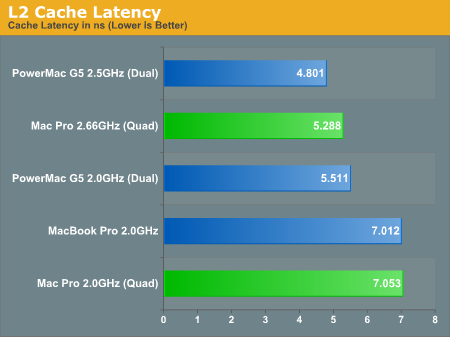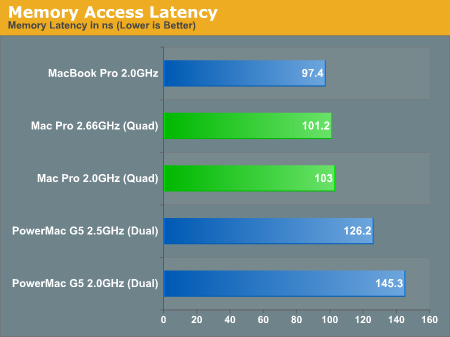Apple's Mac Pro - A True PowerMac Successor
by Anand Lal Shimpi on August 16, 2006 12:27 PM EST- Posted in
- Mac
Memory Performance
We'll start off our look at the Mac Pro's performance with some low level memory tests, since arguably the most controversial aspect of the Mac Pro is its use of Fully Buffered DIMMs. For more information about FB-DIMMs be sure to read our original article on the Mac Pro.

The G5 had a very quick 12-cycle L2 cache, which gives it a slight performance advantage compared to the 14-cycle L2 of the Xeons in the Mac Pro. Access latency is only one part of the puzzle however, as the G5s benchmarked here only had a 512KB L2 cache (the G5 later got an upgrade to a 1MB cache) while the Xeons in the Mac Pro have a 4MB L2 cache per chip. The G5 had a slightly faster L2, but you can reach higher clocks with the Xeon thus minimizing the effective latency and you can fit more data into the larger L2.

And here we see the real killer with FB-DIMMs; although the Mac Pro boasts lower latency memory accesses than the PowerMac G5, it actually takes longer to access main memory than the Core Duo processor in the MacBook Pro. This is much worse than it sounds once you take into account the fact that the MacBook Pro features a 667MHz FSB compared to the 1333MHz FSB (per chip) used in the Mac Pro.
We can further put things in perspective by looking at memory latency under Windows XP, compared to Intel's Core 2 processor. Remember that the Core 2 is identical to the Xeons in the Mac Pro, the difference being that the chipset uses regular DDR2 memory instead of DDR2-667 FB-DIMMs. Note that for our Core 2 system in the comparison below we ran the memory at DDR2-667 at 5-5-5-15 timings as well as DDR2-800 at 4-4-4-12 to provide apples-to-apples as well as apples-to-fastest comparisons.
| CPU | Everest |
CPU-Z 1.35 (8192KB, 256-byte stride) | Everest READ | Everest WRITE |
| Apple Mac Pro 2.66GHz (DDR2-667 FB-DIMM Quad Channel) | 100 ns | 87.4 ns | 4292 MB/s | 3759 MB/s |
| Apple Mac Pro 2.66GHz (DDR2-667 FB-DIMM Dual Channel) | 105.8 ns | 92.3 ns | 4141 MB/s | 3096 MB/s |
| Intel Core 2 Duo E6700 2.66GHz (DDR2-800 4-4-4-12 Dual Channel) | 59.9 ns | 52.8 ns | 7413 MB/s | 4859 MB/s |
| Intel Core 2 Duo E6700 2.66GHz (DDR2-667 5-5-5-15 Dual Channel) | 68.9 ns | 59 ns | 6782 MB/s | 4858 MB/s |
It's not Apple's fault, but FB-DIMMs absolutely kill memory latency; even running in quad channel mode, the FB-DIMM equipped Mac Pro takes 45% more time to access memory than our DDR2 equipped test bed at the same memory frequency. Things don't get any prettier when we look at memory bandwidth either.
Remember the overhead we were worried about with the serialization of parallel memory requests? With four FBD channels, the best we're able to see out of the Mac Pro is 4.292GB/s, compared to the 6.782GB/s of bandwidth our dual channel Core 2 testbed is able to provide. The efficiency table below says it all:
| CPU | Peak Theoretical Bandwidth |
Everest READ | Efficiency |
| Apple Mac Pro 2.66GHz (DDR2-667 FB-DIMM Quad Channel) | 21.3GB/s | 4.292GB/s | 20% |
| Apple Mac Pro 2.66GHz (DDR2-667 FB-DIMM Dual Channel) | 10.67GB/s | 4.141GB/s | 38.8% |
| Intel Core 2 Duo E6700 2.66GHz (DDR2-800 4-4-4-12 Dual Channel) | 12.8GB/s | 7.413GB/s | 57.9% |
| Intel Core 2 Duo E6700 2.66GHz (DDR2-667 5-5-5-15 Dual Channel) | 10.67GB/s | 6.782GB/s | 63.6% |
FB-DIMMs are simply not good for memory performance; the added capacity allowed by having 8 FB-DIMM slots on the Mac Pro had better be worth it, because if Apple were to release a Core 2 based Mac chances are that it could give the Mac Pro a run for its money in a number of memory sensitive tasks.










96 Comments
View All Comments
rockinphotog - Saturday, August 19, 2006 - link
AS a matter of fact, I often use my apple keyboard for my digital camera, printer, syncing my treo and even my wacom tablet.aaronlyon - Friday, August 18, 2006 - link
In next week's article, please evaluate Parallels Workstation for running Windows apps simultaneously with Mac OS. If this works smoothly, why not use Windows versions of Adobe Photoshop and Illustrator? That would be a good solution while waiting for Universal Binary updates.Zebo - Friday, August 18, 2006 - link
Great pics and article Anand.What a deal for such a clean system. They don't build PCs that pretty and this is the best yet from Apple's industrial design squad. I definity want one but don't need four cores.
Can I run Windows fully with this machine? Or maybe I should wait until a single processor (dual core) version comes. If Apple sells $1500 Conroe boxes and it ran windows they counld'nt keep them in stock.
plinden - Friday, August 18, 2006 - link
There's an issue with the speed of SATA hard drives, as Anand mentions here: http://www.anandtech.com/weblog/default.aspx#287">http://www.anandtech.com/weblog/default.aspx#287
It will probably be fixed eventually but if you're relying on this to run Windows, you should wait.
FutureMedia - Thursday, August 17, 2006 - link
You are not comparing the Quad G5 Rear Ports to the Mac Pro Rear Ports. Quad G5 has 3 USB 2 ports as well as 2 Gigabyte Ethernet ports just like the Mac Pro. IE the Quad G5 rear set of ports is IDENTICAL to the Mac Pro rear set - just laid out differently. Only the front adds a fifth USB 2 and second FW800 port not on the Quad G5 which is the same layout as what you show from OLDER not last generation October 2005 PowerMac G5s.Moreover I was looking forward to a Quad G5 comparison with the 2GHz and 2.66 GHz Mac Pros. That is what I want to know. Especially Is even the 2GHz Mac Pro faster than the Quad G5? Is the problem that you don't have a Quad G5 in house to compare it to? I am so bummed out that you didn't compare Mac Pro two bottom speeds with the Quad G5. Please can you do it after next week? I would really appreciate it. Thanks.
PhilG5 - Friday, August 18, 2006 - link
Thank you so much for pointing that out! In fact, Anandtech uses mid-2004 PowerMac G5 (still using AGP graphics and DDR-400 memory!) and doesn't take into account the whole "late 2005" series (which first supported DDR2, PCI-E and had the "Antares" PPC970 core). If you look at Barefeats benchmark results ( http://barefeats.com/quad06.html">http://barefeats.com/quad06.html ) the Quad G5 still seems to be pretty much competitive with the new Mac Pros.Anand Lal Shimpi - Friday, August 18, 2006 - link
We did not have a Quad G5 on hand, however the performance results woult not have been that different. The benchmarks that show little or no scaling between the Dual and Quad Mac Pros would show the same scaling between dual and quad G5s (which were most of the benchmarks). None of our tests were GPU bound, so difference in graphics interfaces should also minimally impact performance. The only real variable that could have changed things is DDR2, however seeing as how none of the DDR-DDR2 transitions we've seen on the PC side have done anything for performance, hopes aren't too high for a tremendous impact on G5 performance.Take care,
Anand
Konq - Thursday, August 17, 2006 - link
Anand - I think something is wrong with the 2 vs. 4 core Xcode test. As with gcc, you can tell it to compile with as many threads as you like. This will compile 4 source files at the same time for instance on 4 cores (multitasking). Perhaps the code was too small to really see a difference, or the environment was not set right?Konq - Saturday, August 19, 2006 - link
OK, now another interesting 4-core note: MacWorld did a test with iTunes and a quad core, 2.5 Ghz G5 beat a dual-core, 2.7 Ghz G5 system when converting 45 minutes of AAC files to mp3. Maybe this was due to having multiple files to work on? AAC->mp3 vs. Wave->mp3?One thing I am interested in now: An article that covers how to get the most out of 4-core systems. Which software benefits and how. Since 4-core processors are coming out soon, this will be needed in purchasing decisions.
Konq - Friday, August 18, 2006 - link
I verified on the Apple Xcode users list that Xcode can indeed take advantage of every core. You might want to modify the test you do and configuration if needed.Great article btw. I enjoy reading reviews from you that can be counted on for true pro's and con's instead of overly rosey approach from fan sites.
In spite of "horrid memory system", it sounds like the system kicks butt! One is in my future...